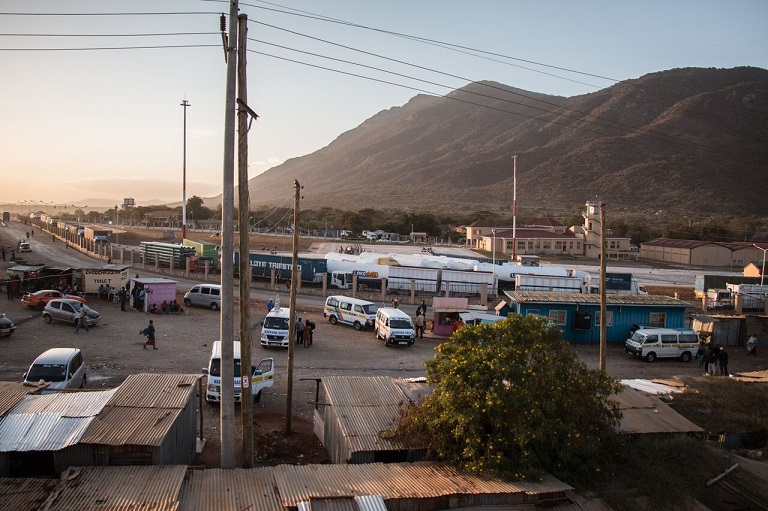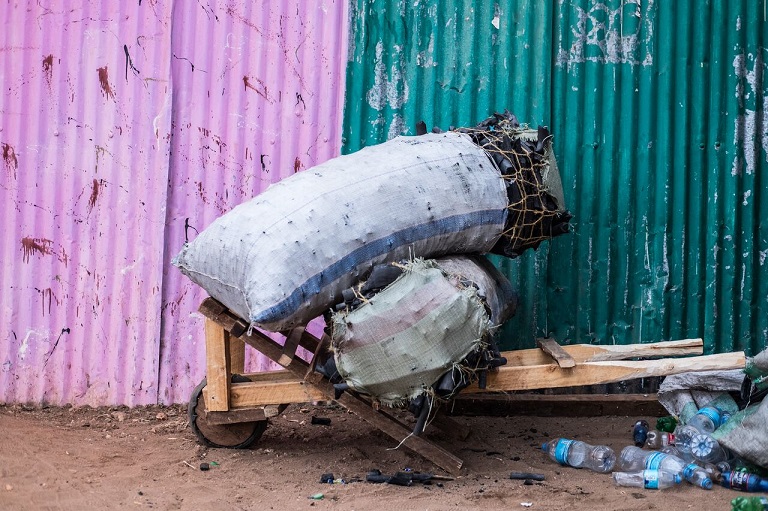- The MOU is intended to stem the illegal timber trade in East Africa, which is fuelling deforestation in the region.
- Several projects included in the MOU, such as increased border patrols and crackdowns on illegal timber transport, are already underway.
- Other initiatives, including harmonizing tax customs documents and financing the MOU for its five-year duration, have been delayed.
- Local woodcarvers who depend on smuggled wood for their trade are seeing their industry decline as a result of the MOU.
LUNGA LUNGA/HOROHORO BORDER POINT, Kenya/Tanzania – Along the porous, 477-mile border between Kenya and Tanzania, small-scale timber smuggling is commonplace. A group of woodcarvers who have done business for the last two decades near the Kenyan border town of Lunga Lunga have long imported a few thousand logs from Tanzania every year. Mostly they utilize bicycles to carry timber through backdoor paths across the border.
But this method of timber smuggling could soon become a thing of the past.
In a bid to halt illegal timber trade between Tanzania and Kenya, the two countries signed a Memorandum of Understanding (MOU) in March, 2015 to increase border patrols, create one-stop border points and harmonize bureaucratic processes like taxes and customs. Only partially implemented, the five-year agreement is expected to “make business much more difficult for the woodcarvers,” according to Edwin Misachi, a forest officer with the Kenya Forest Service based near Lunga Lunga.
While a handful of the initiatives outlined in the MOU – like the one-stop border points and increased collaboration on border patrols – are underway, border officials say a large chunk of the agreement is behind schedule. So far, the committee that will oversee the implementation of the agreement and deal with financing has only met once since the MOU was signed. Known as the technical committee, it is supposed to meet every three months. Harmonization of tax and customs between the two countries – such as different units of measurement of timber shipments on forms – has also been delayed.
The MOU is intended to stem East Africa’s contribution to global illegal timber trade, which accounts for 50-90 percent of the total trade around the world, according to the United Nations Environment Program. It could also help reduce the region’s deforestation rates. According to satellite data from the University of Maryland accessed through Global Forest Watch, Tanzania’s tree cover loss nearly doubled between 2006 and 2014. Overall, the World Wildlife Fund estimates 30 million hectares will be deforested in East Africa between 2010 and 2030.
While experts say the Tanzania-Kenya MOU is a step in the right direction, many are frustrated by delays in the agreement’s implementation.

“Without the technical committee meetings, funding the agreement will be very difficult,” said Jackson Bambo, a forest officer at the Kenya Forest Working Group. Bambo conducted a study in 2011 that found widespread illegal logging was a catalyst for the agreement. “We’re not satisfied with the implementation of the MOU so far.”
Alex Lemarkoko, a commandant with the Kenya Forest Service in Nairobi, said that woodcarvers won’t be the only profession to struggle – all timber smugglers will face “greater enforcement.”. He agrees that delays are being caused by “financial constraints,” but wouldn’t elaborate on specifics.
Collaboration
One of the goals of the deal is harmonization of data, permits and the documentation needed to transport timber. Currently, a trader attempting to transport timber between the two countries must fill out separate forms on each side of the border, according to Bambo. The Kenyan permit, for example, uses “volume” to determine the size of the shipment while the Tanzanian document uses “pieces,” making it very difficult to identify discrepancies.
These discrepancies can be costly to the governments and to the environment. Bambo’s 2011 study found that the Tanzanian government lost approximately $8 million a year in taxes and royalties from timber smuggling. The vast majority of the smuggling was not through back roads on bicycles, but in large consignments that were undervalued or purposefully misidentified.
One factor of the MOU that has been achieved is that Tanzanian and Kenyan officials are now stationed in the same building. Before the agreement, the two governments had border posts that were up to a few miles away from each other, making information exchange problematic. Documents would sometimes take days to reach the other border post. With funding from the Japanese government, which is investing heavily in infrastructure across Kenya, single border points have been built at three different crossings so far. These modern buildings house all the government agencies involved in cross-border trade and traffic.
Increased patrols
The MOU has set in motion a ramp-up of border patrols by both countries. At one of the main border points in Namanga, charcoal is a big, but largely unregulated, business. In October, a group of about 20 Tanzanian and Kenyan border police evicted a few dozen charcoal vendors from their normal place of business in the town’s “no man’s land,” part of a larger plan to clear the approximately 200-foot-wide stretch of land along the border that is neither officially Kenyan nor Tanzanian.
Vendors of all kinds have traditionally operated there with essentially no oversight.
With the construction of the single border point in Lunga Lunga in May 2016, the woodcarvers say their lives have been upended. They were allotted plots of land much closer to the authorities and movement permits for timber are now more strictly enforced. As a result of the increased regulation, reduced timber supply and decrease in tourism, woodcarvers in Lunga Lunga say their industry has declined dramatically.

In the last decade, more than a thousand woodcarvers have left the business, says Martin Mutunga, chairman of the Lunga Lunga Handicraft Cooperative Society, which is the umbrella organization for all the woodcarvers in the area.
The Kenya Forest Service acknowledges that the MOU will hurt the woodcarvers’ business, as they rely on unregulated timber. When asked how they will help them get back on their feet, officials admit there is no strategy to employ the traders or train them for other jobs.
Many say they will return to their homes to farm or search for work as motorcycle taxi drivers in nearby big cities. One of them is Festus Tola, who has been working as a woodcarver for the last 20 years.
“Staying here is impossible,” Tola said.
Banner image: A bag of charcoal for sale in Namanga border point. Photo by Nathan Siegel for Mongabay
Nathan Siegel is a Nairobi, Kenya based freelance photographer and writer. Follow him on Twitter at @nathansieg
Citations:
Hansen, M. C., P. V. Potapov, R. Moore, M. Hancher, S. A. Turubanova, A. Tyukavina, D. Thau, S. V. Stehman, S. J. Goetz, T. R. Loveland, A. Kommareddy, A. Egorov, L. Chini, C. O. Justice, and J. R. G. Townshend. 2013. “Hansen/UMD/Google/USGS/NASA Tree Cover and Tree cover Loss and Gain, Country Profiles.” University of Maryland, Google, USGS, and NASA. Accessed through Global Forest Watch on January 27, 2017. www.globalforestwatch.org.
